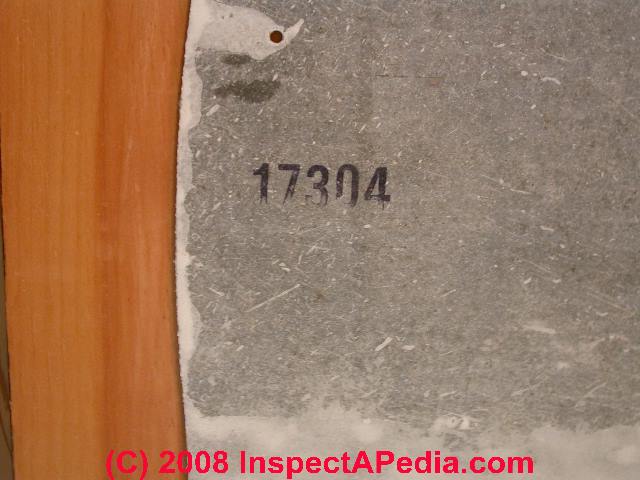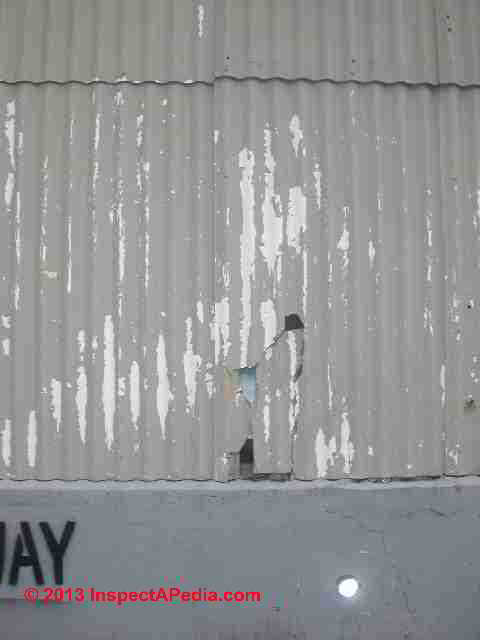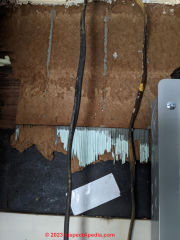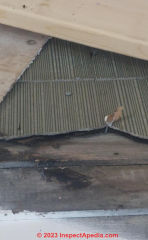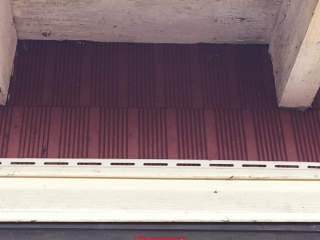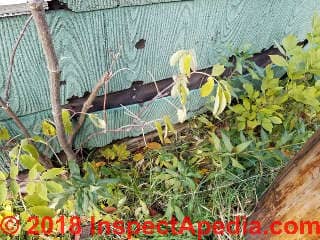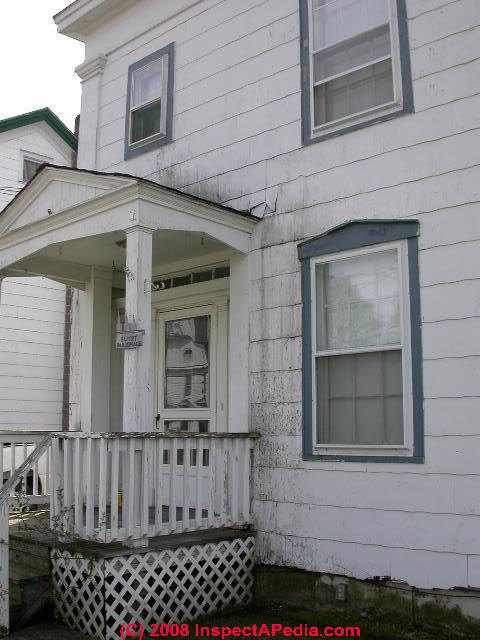 Asbestos Cement Siding or Asbestos Cement Shingles
Asbestos Cement Siding or Asbestos Cement Shingles
Identify & inspect asbestos cement wall siding or wall shingles
- POST a QUESTION or COMMENT about asbestos cement siding on buildings
Asbestos-containing building siding identification.
This article assists building buyers, owners or inspectors who need to identify asbestos materials (or probable-asbestos) in buildings by simple visual inspection.
In the cement asbestos siding article series listed below, we provide photographs and descriptive text of asbestos insulation and other asbestos-containing products to permit identification of definite, probable, or possible asbestos materials in buildings.
While an expert lab test using polarized light microscopy may be needed to identify the specific type of asbestos fiber, or to identify the presence of asbestos in air or dust samples, many asbestos-containing building products not only are obvious and easy to recognize, but since there were not other look-alike products that were not asbestos, a visual identification of this material can be virtually a certainty in many cases.
InspectAPedia tolerates no conflicts of interest. We have no relationship with advertisers, products, or services discussed at this website.
- Daniel Friedman, Publisher/Editor/Author - See WHO ARE WE?
Photo Guide to Cement-Asbestos Wall Shingles or Siding Products
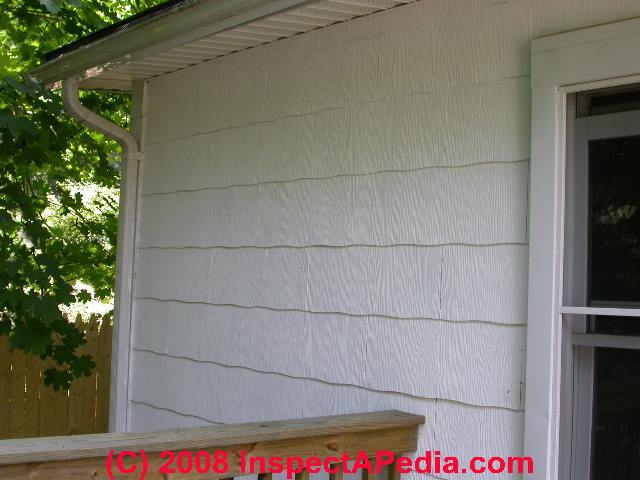 Asbestos cement wall shingles were in popular use in the U.S. from the 1920's (est) through the 1960's (est). A mixture of asbestos fibers and portland cement, the material was durable and fire resistant.
Asbestos cement wall shingles were in popular use in the U.S. from the 1920's (est) through the 1960's (est). A mixture of asbestos fibers and portland cement, the material was durable and fire resistant.
This house, built in the 1920s in Poughkeepsie, New York, had asbestos cement shingles added to its exterior, probably in the late 1950s or early 1960s.
Today on this home we can see both original cement-asbestos wall shingles and newer fiber cement replacement wall shingles (installed by the author) that do not contain asbestos.
This is the "wavy edge" asbestos cement shingle siding product.
But only the installer (the author in this case), an expert, or a lab can tell the new fiber cement from the old asbestos fiber cement shingles - or you can with help of the inspection and repair tips we provide below.
Article Contents
- BUYING a HOME with CEMENT ASBESTOS SIDING?
- ASBESTOS FORMS USED in ASBESTOS CEMENT PRODUCTS
- HOW TO TELL CURRENT FIBER CEMENT FROM OLDER ASBESTOS CEMENT SHINGLE SIDING
- PLANNING TO REMOVE or DEMOLISH ASBESTOS-CEMENT SIDING?
...
Is it safe to buy a home with cement asbestos siding?
In my opinion, yes. Most cementious building materials are considered to be non-friable, and are probably less hazardous than other friable asbestos products such as asbestos pipe insulation.
But still, some care is needed if repairing or even cleaning such a home's exterior.
Watch out: power-washing asbestos cement siding or roofing or breaking it up by doing demolition or renovation can create hazardous asbestos-containing dust even if in-place the shingles are not friable. Also, when installing or modifying older asbestos-cement shingles or even their fiber cement replacements, use a shingle cutting tool, not a power saw, if you need to cut the material.
And removal of asbestos-containing roofing products is regulated as we discuss at ACRM Roofing Disposal Regs.
Asbestos-cement products were developed in an era of ingenuity for creating easy to install and economic building materials.
Although asbestos-cement has acquired a poor reputation by association of its title, it has not gained that reputation through a lack of durability or utility.
In order to preserve this twentieth-century material, understanding what makes, or does not make, asbestos a hazard is truly important.
In this case, no hazard is created when asbestos-cement building materials are sound and left in place, or when treatments incorporate non-abrasive means. - "Keeping a Lid on It..., Woods, NPS technical brief
Friable and nonfriable asbestos are defined separately
...
What forms of asbestos were used in fiber cement products?
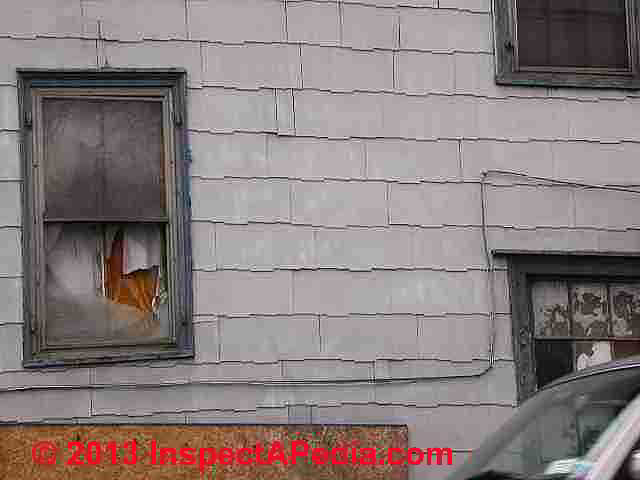 Medium length asbestos fibres and possibly also asbestos shorts or fragments were used in fibre cement products.
Medium length asbestos fibres and possibly also asbestos shorts or fragments were used in fibre cement products.
The fibres, usually chrysotile asbestos (white asbestos), were used to impart strength or resistance to breakage of the asbestos cement product, while shorts or "dust" or fine asbestos particles were used in some products as a filler.
The types of asbestos used may vary, chrysotile is normally always present but crocidolite and amosite (asbestos grunerite) were also added to many products. - (Burdett 2007)
The building shown at left, located in Hughsonville, NY, using the "thatch edged" shingle siding style is almost certainly sided with asbestos-cement shingles.
From the 1940's to perhaps the early 1970's it was popular to cover peeling wood clapboard buildings with this durable material.
We estimate that this building was probably re-sided in the 1960's.
Siding materials that use fibers and aggregate other than asbestos are properly called "fiber cement" building siding products.
Some manufacturers use the term "fiber-reinforced cement" for these products.
All of these products use some sort of fiber along with cement. Before 1978 in the U.S. the common reinforcing fiber used was asbestos.
Asbestos in granular or powder form may also have been mixed in with cement as a filler when these products were manufactured.
...
How can we tell the difference between asbestos-containing shingles and fiber-cement wall shingles?
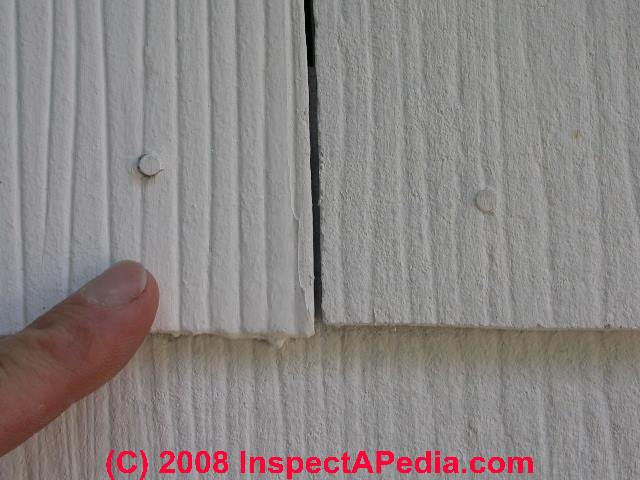 In this photo I point to an older asbestos cement siding shingle while to the right of my finger the next shingle is a modern asbestos-free fiber cement siding shingle.
In this photo I point to an older asbestos cement siding shingle while to the right of my finger the next shingle is a modern asbestos-free fiber cement siding shingle.
I know the difference because I installed the new material. Otherwise, without close inspection or a lab test it would be difficult to say which was which.
On this home shown we installed replacement fiber cement shingles that contain no asbestos; they matched exactly the profile and wood grain pattern of the original shingles installed in the 1940s or 1950s.
First, a local cable television installer, called to install a new coaxial TV cable, stapled his wire around two sides of the home, breaking every shingle he touched!
Second: in the course of adding a rear deck to this home we converted what had been a kitchen window to a sliding glass door - requiring some new fiber cement shingle work outside on the wall around the door.
Here are some ways to distinguish between asbestos containing shingles and non-asbestos fiber-cement shingles.
- Age or date of fiber cement or asbestos cement shingle siding installation:
installed before 1978 the fiber-cement shingles probably contain asbestos.
- Layers of paint or finish coatings;
the original shingles of both asbestos-cement and fiber cement usually come from the factory painted white on one side.
Owners often painted cement asbestos shingle siding to make it look fresh, or if it was weathered and fuzzy, to preserve it.
On a building that has has a portion of its original cement asbestos shingles replaced with newer fiber cement shingles, and where some original asbestos cement shingles remain, you'll see a difference in the thickness of layers of paint on the two materials.
The shingle at the right in the photo above clearly has fewer paint layers than the one at left (pointed to by my finger). At the lower right corner of the leftmost shingle (under my finger) you can even see a paint droplet.
So I know that the left shingle is an older asbestos-cement shingle and the right photo is a new fiber cement shingle - one that we installed.
In our next asbestos cement shingle siding photo below we illustrate why additional coats of paint on a fiber cement or asbestos cement siding shingle means future painting maintenance will be required. The subsequent paint job was peeling off of the asbestos-cement shingle siding.
Proper paint preparation (cleaning) and priming, then painting with paints recommended for use on this material may give better results than we see at above right.
- Remodeling or Repairs: look for shingle differences around new or more-recent work.
If an asbestos-cement sided home has been re-modeled such as by adding a window or door, it's likely that the old asbestos cement shingles were broken around that new opening during the construction work - expect to see newer fiber cement shingles there.
- The back of a new fiber cement wall shingle
will probably have a code stamped on it such as we show above.
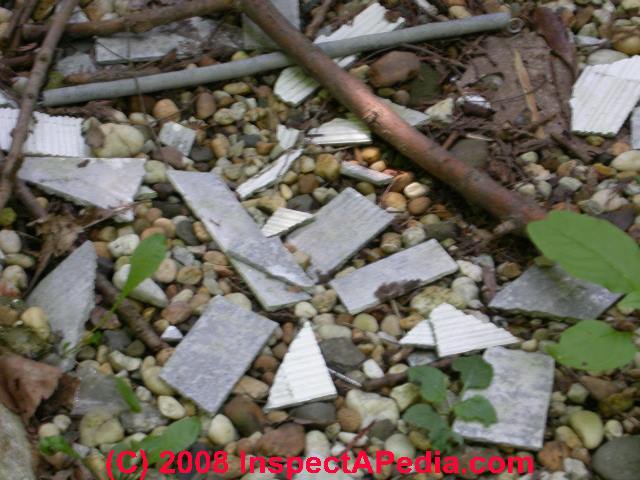
- The presence of old dirty demotion materials
may suggest that old asbestos cement shingles have been removed from the home even when new, completely different materials are installed.
We found this cement asbestos siding debris on the ground around a home that boasted new vinyl siding. - The presence of multiple layers of exterior siding
can be spotted by noticing that the wall cladding extends out past the original window or door trim.
But beware; when we renovated the building shown above we built-out the exterior trim so that it would continue to project beyond new vinyl siding installed on some wall surfaces. - The nails
used to secure the shingles probably won't help unless some are obviously different from others; installers use the same galvanized box nails to hang these shingles as they did in 1955.
Watch out: because fiber cement siding manufactured in North America after around 1978 was made without using asbestos in those later products, and because those non-asbestos fiber cement shingles included products that by eye were an exact visual match for their older asbestos-containing brothers and sisters already installed, a building built before 1978 and sided with cementious shingles may contain a mix of both asbestos-containing and non-asbestos-containing cementious shingles.
Why? From first hand experience I note that we often made repairs to or replaced damaged asbestos cement shingles with non-asbestos-based fiber cement shingles on older buildings. So any older building could contain a mix of asbestos- and non-asbestos cement shingle siding.
Watch out: if you are testing fiber-cement shingles on an older building for asbestos content, be sure that you select for testing one of the older shingles installed before 1978. Else you may miss asbestos containing material on the building. Clues given just above can help you select older shingles for tests for asbestos.
...
Planning demolition of cement asbestos siding or shingle siding materials?
The risk of high levels of airborne asbestos from cementious products is probably low unless the workers are using power equipment like sanders and saws on these substances.
I found that by working carefully it was possible to remove whole asbestos-cement shingles intact. Breakage was rare. And of course I'd never use a power saw on such siding.
Our photograph illustrates that corrugated asbestos cement (or on newer buildings corrugated fiber cement) panels are also used as siding, not just as a roofing product.
This building whose siding is shone here was observed in New York City.
Based on its age, we suspect that the material shown is asbestos cement corrugated siding, not a newer fiber cement product.
Using cement asbestos roofing products as an example, according to NRCA, the National Roofing Contractors' Association, their studies up to February 1992 had not found a single roofing job at which these limits were exceeded, and NRCA reported that in some cases no fiber release was detected.
But it appears that the association may have been referring only to asphalt-based roofing materials, not jobs involving the demolition of other ACRM such as cement-asbestos roof shingles (or "asbestos roof tiles" as some consumers refer to them) which might produce different statistics.
...
Early History & Age of Asbestos-Cement Siding & Roof Shingles: Production & Use
and
History of Uses of Asbestos in Modern Products
Information on the early and modern history of asbestos use in building products can now be found
at HISTORY of ASBESTOS USE in BUILDING PRODUCTS
...
Reader Comments, Questions & Answers About The Article Above
Below you will find questions and answers previously posted on this page at its page bottom reader comment box.
Reader Q&A - also see RECOMMENDED ARTICLES & FAQs
Question: Did the fiberboard backing of 1960's asphalt cement shake siding also contain asbestos
Did the fiberboard backing of 1960's asphalt cement shake siding also contain asbestos, or was it just added to the cement? 2023-04-02 Kim
Reply by InspectApedia Editor - Asbestos in Fiberboard Backer used on Cement Asbestos Siding or Roofing?
@Kim,
Asbestos-cement siding or roofing was, as you suggest, a mixture that contained cement and asbestos; if you have a fiber-cement shake siding product on your building and that product includes a fiberboard backing, that product is most likely a wood or plant fiber product. Not asbestos.
Of course as they are bound together, on demolition or dissection, some of the cement-asbestos material would probably be bound to the fiberboard backer.
Asbestos would be uncommon in fiberboard, though we have reported on some exceptions, such as by cross-contamination.
Those details can be read at
SHEATHING, FIBERBOARD ASBESTOS CONTENT
Note: This answer presumes that you meant to type "Asbestos Cement Shake Siding" - you wrote "Asphalt Cement Shake" which is not a product term that we know.
Asbestos in Asphalt Shingle Siding or Roofing?
There was a siding product that we'd call asphalt-siding sold in a wide range of patterns, some of which resembled brick or even "wood" in a pattern. That product is a mineral-granule-surfaced asphalt-impregnated paper that, in older versions, often contained asbestos.
Those details are at:
ASPHALT SIDING CONTAINS ASBESTOS?
and at
ASPHALT ROOF MATERIAL ASBESTOS
Please let me see details of the siding about which you're asking. Post photos (one per comment) of the siding exposed face, another of its edge and if you have some that is not attached to a building, show me a photo of the back surface of the material.
Also tell me the age of the building itself and its location.
Thanks for a helpful question. - DFOn 2023-04-03 by Kim
@InspectApedia Editor , sorry for the chopped reply. This is an image of the small amount left over. Primarily, I am wondering if this brown backing is safe-ish.I presume the blue part is asbestos cement since it's c. 1960. Most is just fiberboard left. What % asbestos are we talking in this type of siding?
On 2023-04-03 by InspectApedia Editor - percentage of asbestos in asbestos cement siding
@Kim,
Thanks for the very helpful photo: yes that looks like a common fiberboard (plant-based) backer-board adhered to asbestos-cement or fiber cement shingle siding.
In addition to asbestos content in the FC siding, asbestos may be present in the mastic adhesive used to bond the fiberboard to the FC shingle.About the percent asbestos in asbestos cement siding, Rosato, one of the original experts on the topic, put that at over 50% in some products. The manufacturers used both long fibers for strength and shorts or in essence waste asbestos "dust" as a filler material mixed with cement.
Sometimes we see lab reports giving a much lower percentage of asbestos in products: I [DF] worry that in some cases and with some procedures, the lab may not be looking for the shorts and fragments.
Question: Asbestos cement - or fiber cement siding look identical on buildings
I own a home in upstate NY that is sided with the product shown attached. I have been attempting to identify the siding since there seems to be varying levels of concern with the “asbestos” subject. Frankly, I am NOT concerned because I am not, nor will I be performing enough cutting or disturbance to rile up any asbestos fibers.
However, I found your wonderfully comprehensive site regarding the subject and am still a bit confused as to the amount of asbestos that may be in our siding. I think I understand that there were different amounts at different points of manufacture.
Can you give me an idea based on what you see and/or can I mail you an actual sample for confirmation? Please give me an idea of your fee for service and timing once you have the sample.
My inquiry is the result of a neighbor who regards himself to be an expert and has taken to warn others about getting close to the stuff! 2022-10-15 by Anonymous
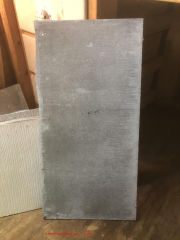
Reply: unless there's significant disturbance of the siding material, it's safest left alone
@Anonymous by private email,
Asbestos cement - or fiber cement siding look identical on buildings. Neither is friable. Unless the material is being ground, chopped, sawn, or perhaps power-washed there is no detectable hazard from its presence.
If I didn't make this comparison before, tell your neighbor that the material is NOT radioactive. It doesn't emit harmful particles on its own. Asbestos doesn't "jump" out of fiber cement siding. The siding might shed a small amount of surface material from weathering, more from power-washing. But unless there's significant disturbance of the material it's safest left-alone, in place. I'm doubtful that your neighbor can find an informed, qualified expert who'd say otherwise.
About testing, in my OPINION there is no justification for testing this siding for asbestos.
If your home's siding was installed in the U.S before the mid 1980s, at least some, if not all of those fiber cement shingles would contain enough asbestos that you'd not want to create a dusty mess.
Because it's possible to buy and install replacement fiber cement shingles that look identical to their original asbestos-containing sisters, even testing a sample and finding that it contained no asbestos
would be NO assurance that other siding on the building was asbestos free.
**IF** you had to demolish the siding by chopping, sanding, etc., the you would treat it as presumed to contain asbestos. Else, leave it alone; it's not hurting anyone.
Question: Did Bird Siding contain asbestos?
I have Siding on the house that says bird est 1795. Do you think that has asbestos in it? 2022-09-18 by Ellen
Reply: In vinyl siding? No. In asphalt-based roofing products that could be used on walls? Maybe.
@Ellen,
Watch out: SOME (not all) Bird Corporation siding products contained asbestos.
The Bird company, dating from a 1795 paper mill, later produced both roofing and siding products, including vinyl siding.
So identifying the material about which you ask (is your siding vinyl?) is important.
If your building siding is vinyl, it's not asbestos.
The principal asbestos-containing siding products produced by Bird and Son were
- Roof coating products (asphalt-asbestos)
- Roofing Cement (containing asbestos)
- Possibly asbestos-containing asphalt roof shingles
If someone used asphalt-based shingles on your home's walls, those may have contained asbestos.
The date of installation would also be an important clue.Contact: Bird Corporation 1077 Pleasant Street Norwood, Massachusetts 02062 U.S.A. (617) 551-0656 Fax: (617) 762-6586
About another common asbestos-containing siding,
I have not found any indication that Bird and Son produced asbestos cement siding - a different building siding product that we discuss
On 2022-07-31 by Remodeling help: Is this asbestos?
We are currently adding an addition to our 1910 home and under the wood siding, we found this. By visually looking at this, is this asbestos? Thank you!
Reply: if installed in North America before 1986, likely to contain asbestos
@Remodeling help: Is this asbestos?,
Yes, if that fiber-cement shingle siding was installed in North America before 1986 it's likely to contain asbestos.On 2022-08-01 by Remodeling help: Is this asbestos?
@InspectApedia-911, thank you for your response. If we cover this up with drywall, is it correct that we will not need to worry about it contaminating our home, or am I understanding incorrectly?
On 2022-08-01 by InspectApedia-911 (mod) - can we put drywall on top of the asbestos siding
@Remodeling,
Fiber cement or asbestos cement is not friable but it can shed particles if severely weathered, damaged, broken up during demolition, or power-washed.
If this is your building's exterior siding and if it's covered by other siding then it has no detectable effect on the building and its hazards.
If I understand correctly, you're adding an addition that abuts an exterior wall that has asbestos-cement shingles that are already covered by wood siding. If that's the case, no further covering would normally be needed.
You can, of course, add a layer of drywall, and in fact local building codes might require it for fire-safety when building additional occupied space - check with your local building department.
Keep in mind that nailing drywall to wood siding and / or to fiber cement shingles can cause the shingles to break a bit. So you may still have some cleanup to do if that material falls out into exposed areas of the roof.On 2022-08-02 by Remodeling help
@InspectApedia-911, thank you for this info. The drywall would be going on top of the asbestos siding so we don't disturb it more than we need to...hopefully. there is no wood siding on top of the asbestos siding.
On 2022-08-02 by InspectApedia-911 (mod)
@Remodeling help,
Got it. OK so I expect you may see some asbestos-cement shingle breakage when installing the drywall.If you're seeing a lot of that and don't want to face the cost and trouble of removing it properly, you might consider installing drilled-screwed-up furring strips to carry the drywall.
On 2022-08-02 by Remodeling help
@InspectApedia-911,
Thank you so much! You have been incredibly helpful. I am so glad I found this page!On 2022-08-03 by InspectApedia-911 (mod)
@Remodeling help,
Glad to assist; working together helps us both.
Question: how do I removed asbestos cement siding?
My home has asbestos siding. Underneath it it appears there is wood siding. If I remove the asbestos cement siding from my home, is the siding underneath it contaminated as well? Will have to to remove the wood siding as well? 2022-07-18 by James
Reply - need to follow the proper steps to remove asbestos cement siding
@James,
Removing cement asbestos siding is likely to create a lot of hazardous dust and some of that dust might be on the surface of the wood siding that is then exposed so you might need to clean that surface.
But don't assume that the wood siding on the building that you expose is going to be in great condition.
Usually the reason people install some siding over original wood clapboards is that there was repair or at least a paint job needed.
If you're going to remove asbestos cement siding you need to follow the proper steps to avoid creating or losing control of hazardous dust and debris and of course to wear the correct personal protective equipment.
It doesn't mean it can't be done it just means it needs to be done properly.
Question: Are old and cracked asbestos house shingles a threat?
Are asphalt/asbestos house shingles a threat to occupants health if old and cracked? 2021-07-06 by Briget
Reply - Asphalt shingles are basically not "friable"
@Briget518,
Technically and more-precisely, the siding might indeed be shedding bits of material onto the soil below as it is exposed to weather.
Realistically: Asphalt shingles are basically not "friable" - you can't crush the asbestos-containing material to a dry powder between thumb and forefinger; so unless the asphalt-shingle siding is being disturbed by repair or demolition, it's not likely that it's creating a detectable, measurable, or significant airborne asbestos hazard.
Question: does our 1940 siding contain asbestos
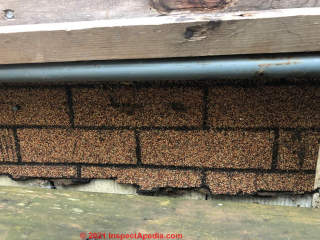 Hello,
Hello,
We have purchased an old cottage/home that was built in 1940. It has an exterior siding that has been covered up on most of the home.
[Photo above]
Do you think this might contain asbestos?
Thank you! 2021-03-28 by Adam
Reply:
@Adam,
That siding is not an asbestos-cement product like those discussed on this page.
Instead, it is an asphalt-impregnated paper or hardboard product.
Please see details at SIDING ASPHALT SHINGLE or SHEET
Watch out: I would also look closely at what is under that asphalt siding as we might also have a layer of asbestos-cement shingles there.
Question: what type of asbestos is used in siding shingles?
What type of asbestos was usually used in these siding shingles? I believe to have some on an indoor porch/ mud room type room on my house and did not know for the last 3 years what it was. I’m a bit concerned about exposing myself and my family to it from some small cracks and repeatedly hitting one shingle with the door knob during that time.
I read chrysotile isn’t as bad as amosite and other amphiboles, but I was wondering that’s true and what type these shingles would most likely consist of. 2021-01-15 by Anon
Reply:
Anon
That doesn't sound like a measurable nor detectable asbestos hazard.
The composition of asbestos cement products is given by Rosato at ASBESTOS CEMENT PRODUCTS https://inspectapedia.com/hazmat/Asbestos_Cement_Products.php
Question: does my stucco cement board siding contain asbestos
We have a house in North Carolina built in 1979 that has 4x8 stucco cement board siding. Would this contain asbestos? 2021-01-14 by Mark
On 2021-01-14 - by (mod) -
Mark
Forgive me but I don't know what "stucco cement board" is - that's not a product name with which I'm familiar.
"Stucco" is generally used to mean a cementious coating applied to a wall. Is your home clad in 4x8 sheets of pre-fab, pre-stucco-coated surface cement board?
Question: what is the R value for Asbestos-Cement siding?
Thank you for your complete site here - it's amazing! Without digging any deeper, what is the R value for Asbestos-Cement siding? 2021-01-08 by Mark Tomlinson
Reply:
Mark
The R-value of asbestos cement siding (or shingles) is given in
INSULATING R-VALUES & PROPERTIES of VARIOUS MATERIALS
Question: does slate siding contain asbestos?
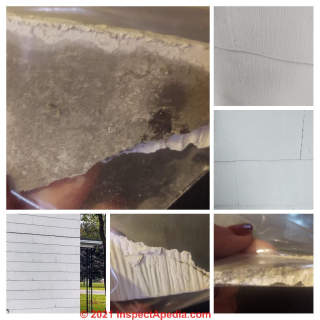 Hi I was wondering if you, in your expert opinion thought this slate siding has asbestos?
Hi I was wondering if you, in your expert opinion thought this slate siding has asbestos?
The house was built in 1920 and the people who we bought it from had lived here from around 1963 or 1965 until 2010.
My homeowners insurance just lists it as slate siding and doesn't mention anything about asbestos on my policy.
However with insurance going up all the time I wanted to switch it to my other insurance that I have my autos through.
My agent who is a friend of mine said they needed to see pictures of it and then he told me they couldn't insure it because it has asbestos.
They never came and inspected it or anything but I'm just wondering how One insurance company can insure it and another one won't.
I would appreciate any help you could give me. Thank you. 2020-09-14 by Tina Young
Reply -
Tina that is not slate siding in your photo, it is fiber cement siding, and if it's from the 1960s, it's asbestos-cement siding. You'll find matching images on the page above.
Regarding "insuring" the siding: insuring against what? It is a very durable material, weather and fire-resistant.
So I'm baffled by your insurance company's position on refusing to insure a home with fiber cement siding - or perhaps they are just concerned about extra costs involved in repairing the siding if it is an asbestos cement siding.
This siding, if it's mechanically damaged such as by impact, the damaged piece can be replaced with an identical-looking modern fiber cement siding shingle that does not contain asbestos.
Those details are at ASBESTOS CEMENT SIDING REPLACEMENT
Question: My builder said this is plywood siding - I think it's something else
I'm hoping you can give me your opinion on this siding. I wasn't sure how to post a photo in the comments. It was put on a cottage in Northern Ontario (Canada) we think around 1965. We were told by a siding contractor yesterday that this is plywood siding.
It's in much better condition than the surrounding wood so that doesn't make complete sense.
It doesn't look like the asbestos shingles I see online. Have you seen this pattern? - Anonymous by private email, Toronto 2020/07/03
Moderator reply: asbestos cement shingle siding or (less-likely) mineral-covered asphalt/fiberboard/metal shingles - turns out to be plywood!
My friend Alan Carson, from Carson Dunlop Associates in Toronto, (a home inspection and education firm) suggests that the dark siding we see in your photo underneath the vinyl siding may be cement asbestos or fibre cement shingles.
It should be trivially easy to make a distinction between a wood product like plywood (softer, wood fibres on probing, joints in 4 ft or 8 ft or greater centers) and fiber cement or asbestos cement shingles (hard, cementious, many smaller pieces and joints).
Plywood siding will be, quite obviously, a wood product showing wood grain and fibres if cut, scraped, or poked. Asbestos-cement siding will be cementious.
Alan Carson said:
Looks like a fiber cement (asbestos cement back then) siding. Maybe manufactured by Johns Manville. Or possibly Gold Bond.
The 1965 construction date, if accurate makes me think the asbestos cement siding would be original. I don’t suspect there would be an additional layer of siding beneath.
I have always thought of this as very good quality siding. Very popular in war time and post war housing here.
Johns Manville in Canada collapsed in 1982, with many asbestos lawsuits.
Some Canadian history here: https://www.brownlawyers.ca/johns-manville.html https://www.brownlawyers.ca/johns-manville.htmlhtml.
- Mr. Carson is a frequent contributor to InspectApedia.com and Carson Dunlop's illustrations are used (with permission) across the website.
Carson, Dunlop & Associates Ltd., 120 Carlton Street Suite 407, Toronto ON M5A 4K2. (416) 964-9415 1-800-268-7070 info@carsondunlop.com. The firm provides professional HOME INSPECTION SERVICES, HOME INSPECTION TRAINING, Horizon INSPECTION SOFTWARE & PUBLICATIONS.Alan Carson is a past president of ASHI, the American Society of Home Inspectors. Thanks to Alan Carson and Bob Dunlop, for permission for InspectAPedia to use text excerpts from The Home Reference Book & illustrations from The Illustrated Home.
We agree with Mr. Carson.
Reader follow-up: It's not plywood siding. It is very hard material.
I really appreciate your reply. I agree it's not plywood siding. It is very hard material.
Is there a way to determine whether it's fiber cement (without asbestos) or asbestos cement shingles? We would like to replace it with wood siding and would like to remove it first regardless.
The joints aren't obvious. It looks more like long strips than shingles. It does not appear to have been painted as the grooves are evenly defined.
Are there any more clues I can look for to determine what it is?
Moderator reply: more clues to identifying hard shingle siding: Asbestos cement vs mineral-granule asphalt shingles or metal shingles
- Expose enough to get a better photo or several to me
- Give dimensions of one segment
- Age of building
- Is that mystery material atop wood clapboard?
- What does window trim look like.
- Where are nails visible?
Reader follow-up: it was plywood!
The cottage is in the Haliburton area and we live in Toronto. I will take more photos next week when we go up.
The building was built in 1965. It was a water access hunting cabin (700 square feet). Now there is a road in.
There is beige vinyl siding on top of the suspect siding. The suspect siding shows under the roofline. The windows look original. They have old screened awning vents that open inward. The window trim and doors also look original and are brown wood.
Yes, I can see some nails on the suspect siding. They are capped with the same colour as the siding so they blend right in. They are in the attached photos.
We would like to remove all the siding and put wood siding on. We purchased the place a month ago.
Moderator reply:
Thank you for the added photos; the colour-matched exposed nails, the size of individual siding shingles, the vertical grooves, its hard cementious nature, the age of the building, and Al Carson's remarks all argue that on the home what you're showing is probably asbestos cement shingle siding, probably original, (on still older homes, sometimes installed atop older clapboards).
Often on an older building this asbestos-cement shingle siding was installed rather than re-paint. It is a very durable, fire-resistant material and one that I prefer to leave alone.
See ASBESTOS CEMENT SIDING [above on this page - Ed.]
where there are similar grooved asbestos cement shingle siding photos, though not in this exact color and grooved pattern. I suspect this is a Canadian product.
The other possibility is a mineral-granule coated asphalt-based shingle siding or a mineral-granule-coated fiberboard based shingle siding.
IF that were the case, a close examination of or probing the bottom edge of the shingle material will expose it black asphaltic- or brown soft wood fiber substrate.SIDING ASPHALT SHINGLE or SHEET - shows both asphalt- based and asphalt/combined with fiberboard- based mineral granule covered shingle siding in various forms.
Below is an example.
In both cases, as both products may contain asbestos, removing this siding will add cost to your renovation job; either treat the material as presumed to contain asbestos or have a sample tested.
Expert sources universally advise that the safest, and least-costly approach to such material is to leave it alone, intact, in place, covering it over if appropriate.
I asked about windows and trim to form a guess at whether the reddish brown grooved cementious siding was original or if instead it was itself installed atop older wood clapboards. If there are multiple layers of siding on a building often the trim begins to recede into the walls - unless it is built-out by the contractors.
That detail can tell us what to expect during a renovation or re-siding job.
Reader follow-up:
Just to clarify we think the timeline is...
1965 - water access cottage built with brown wood siding
1976 - road was put in allowing for easier access. Original owner died this year and cottage was transferred to wife. It is likely the red siding was put on after this point. We are not sure exactly when but likely when the original wood siding was in need of repair
2008 - property changed hands within same family (transferred to son). After this we suspect siding was updated to beige vinyl siding
So the red siding was most likely put on after 1976. Assuming wood siding would have lasted at least 15 years that would be 1980.
Was asbestos in fiber cement siding in 1980 in Canada? Have you seen 80s siding that looks like this?
Moderator reply:
no, but I don't know this siding pattern at all, not as fiber cement, not as plywood.
Reader follow-up: it's plywood siding
2020/07/12 We scraped the siding with a knife and it's officially plywood! :-)
On 2013-03-26 by KCasey
Much like Gord, our house has the Asbestos shingles over cedar. However, we'd been advised to not put a 3rd layer of siding over the asbestos/cedar mix. It was mentioned through securing, it will release the particles by our contractor. Truth? Or a ploy to get more work ($$) by getting down to the base of the structure? 2013-03-26 by KCasey
On 2013-03-26 - by (mod) -
K Casey
I'm not sure that there'd be much particle release during a careful side-over on asbestos-cement siding shingles unless the contractor does something stupid like running power saws, grinders, tools and cutting, sanding, or smashing up the siding.
There is a technical or aesthetic problem that you will want to build out window and door trim so the house doesn't look weird with such thick covering layers on the exterior walls.
On 2012-11-15 by Gordon
We are interested in buying a house built in 1905 that has asbestos-cement siding tiles. Underneath these tiles exists the original siding of wood shingles. Would it be worth our while to have the tile removed and to restore the shingles, or would that be biting off more than we could chew? Thanks!
On 2012-11-28 - by (mod) -
Gordon,
You can do either.
I've tried gentle cleaning and bleaching (power washing may cause damage and make asbestos dust issues)
And
Painting, which worked well, looked good, but has to be repeated on occasion as that converts a no-maintenance surface into one that will need periodic repainting
And
Siding over with vinyl which is more costly, may require building out window and door trim, and can require some care in nailing or using vertical furring strips.
If siding over, don't put a vapor barrier on the outside of the walls if in a northern climate.Worthwhile is a subjective decision - the siding you have on the home is usually quite durable and if not extensively broken or damaged, functional. Removing it and restoring wood shingles, in my experience, will be costly if for no other reason than the probable need to replace a lot of the original shingles you'd uncover. That's because people generally didn't install a new layer of building siding until the original layer was in poor shape.
On 2012-11-28 by Gord
Oh, thanks, Dan. I think we'll either just paint it or cover it with vinyl.
On 2012-12-01 by Gord
Thanks for the good advice. We decided not to buy that house as it turned out to have a rotten roof, but there are lots of houses in the region with asbestos siding so it's good to know our options. There's another house that has diamond-shaped asbestos siding; they're in better shape than the ones on the other house.
Thank you to our readers for their generous comments
On 2023-04-04 by Kim
@InspectApedia Editor , thank you so much for your valuable information. You are incredibly helpful.
On 2023-04-04 by InspectApedia Editor
@Kim,
We're glad to assist. Working together helps us both.
Daniel
...
Continue reading at ASBESTOS CEMENT SHINGLE WEAR SIGNS or select a topic from the closely-related articles below, or see the complete ARTICLE INDEX.
Or see ASBESTOS CEMENT SIDING FAQs - questions & answers posted originally at this page
Or see these
Recommended Articles
- ASBESTOS CEMENT PRODUCTS
- ASBESTOS CEMENT SIDING - home
- ASBESTOS DISPOSAL REGULATIONS
- ASBESTOS & FIBER CEMENT ROOFING - home
- ASBESTOS REMOVAL, WETTING GUIDELINES
- FIBERBOARD ROOFING & FIBER-WOOD ROOFING - home
- PERMA-STONE EXTERIORS
- SIDING ASPHALT SHINGLE or SHEET - some asphalt shingle products contain asbestos too
- SIDING, FIBER CEMENT - newer non-asbestos cement-based siding
- STONE VENEER WALLS - some permastone products contain asbestos
Suggested citation for this web page
ASBESTOS CEMENT SIDING at InspectApedia.com - online encyclopedia of building & environmental inspection, testing, diagnosis, repair, & problem prevention advice.
Or see this
INDEX to RELATED ARTICLES: ARTICLE INDEX to ASBESTOS HAZARDS
Or use the SEARCH BOX found below to Ask a Question or Search InspectApedia
Ask a Question or Search InspectApedia
Try the search box just below, or if you prefer, post a question or comment in the Comments box below and we will respond promptly.
Search the InspectApedia website
Note: appearance of your Comment below may be delayed: if your comment contains an image, photograph, web link, or text that looks to the software as if it might be a web link, your posting will appear after it has been approved by a moderator. Apologies for the delay.
Only one image can be added per comment but you can post as many comments, and therefore images, as you like.
You will not receive a notification when a response to your question has been posted.
Please bookmark this page to make it easy for you to check back for our response.
IF above you see "Comment Form is loading comments..." then COMMENT BOX - countable.ca / bawkbox.com IS NOT WORKING.
In any case you are welcome to send an email directly to us at InspectApedia.com at editor@inspectApedia.com
We'll reply to you directly. Please help us help you by noting, in your email, the URL of the InspectApedia page where you wanted to comment.
Citations & References
In addition to any citations in the article above, a full list is available on request.
- Asbestos products and their history and use in various building materials such as asphalt and vinyl flooring includes discussion which draws on Asbestos, Its Industrial Applications, D.V. Rosato, engineering consultant, Newton, MA, Reinhold Publishing, 1959 Library of Congress Catalog Card No.: 59-12535 (out of print).
- "Handling Asbestos-Containing roofing material - an update", Carl Good, NRCA Associate Executive Director, Professional Roofing, February 1992, p. 38-43
- EPA Guidance for Controlling Asbestos-Containing Materials in buildings, NIAST, National Institute on Abatement Sciences & Technology, [republishing EPA public documents] 1985 ed., Exposure Evaluation Division, Office of Toxic Substances, Office of Pesticides and Toxic Substances, U.S. Environmental Protection Agency, Washington,D.C. 20460
- EPA, ASBESTOS IN YOUR HOME [PDF] - U.S. EPA, Exposure Evaluation Division, Office of Toxic Substances, Office of Pesticides and Toxic Substances, U.S. Environmental Protection Agency, Washington,D.C. 20460
- NRCA Roofing and Waterproofing Manual, 4th Ed., available from the National Roofing Contractors' Association.
- "Tips for working with fiber-cement roofing products", Thomas L. Smith, AIA, RRC, Professional Roofing, September 1996
- "Copy on file as - /exterior/Asbestos_Cement_Shingles_NPS.pdf - Keeping a Lid on it - Asbestos Cement Building Materials - ", Amy Lamb Woods, Technical Preservation Services, National Park Service, 2000. Web search 07/08/2010 original source: http://www.nps.gov/history/hps/tps/recent past/asbestosarticle.htm
Asbestos-cement products were developed in an era of ingenuity for creating easy to install and economic building materials. Although asbestos-cement has acquired a poor reputation by association of its title, it has not gained that reputation through a lack of durability or utility. In order to preserve this twentieth-century material, understanding what makes, or does not make, asbestos a hazard is truly important. In this case, no hazard is created when asbestos-cement building materials are sound and left in place, or when treatments incorporate non-abrasive means.- END NOTES to the above article provide excellent historical references for asbestos cement products:
1D.V. Rosato, Asbestos: Its Industrial Applications (New York: Reinhold Publishing Corp., 1959), 1, 62. This text is an excellent resource for information on the manufacture and production of asbestos products.
2 L. Michaels and S.S. Chissick, eds., Asbestos, Properties, Applications, and Hazards (New York: Wiley, 1979), 1-2. Resource for various kinds of asbestos, their properties and chemical constituencies.
3 Arnon Bentur and Sidney Mindess, Fibre Reinforced Cementitious Composites (London: Elsevier Applied Science, 1990), 288-304. This text reviewed long-term performances of asbestos-cement and concluded that “in natural weathering the composite is excellent.” More detailed quantitative material properties are also given in this text.
4 L. Michaels and S.S. Chissick, eds., 306-312
5 United States Department of the Interior Bureau of Mines, Materials Survey: Asbestos, (Washington D.C.: US Government Printing Office 1952), I-1 - I-4.
6 Caleb Hornbostel, Construction Materials: Types, Uses and Applications (New York: John Wiley & Sons, 1978), 82.
7 H. W. Johns, Patent Trademark Materials: Asbestos (New York: H. W. Johns Manufacturing Co., 1878), 12.
8Rosato,63.
9 D.A. St John, A.B. Poole, and I. Sims, Concrete Petrography: A Handbook of Investigative Techniques (London: Arnold Publishers, 1998), 320-322.
10"Asbestos-Cement Products for War buildings," Asbestos (April 1942), 2-4
11 Rosato, 75.
12 The National Board of Fire Underwriters, Dwelling Houses (New York: The National Board of Fire Underwriters, 1920), 36-37.
13 Ernest G. Blake, Roof Coverings: Their Manufacture and Application (New York: D. Van Nostrand Company, 1925), 144-171. Resource for detailed descriptions of many asbestos-cement roof shingle forms, styles, and hardware.
14 James McCawley, Asphalt and Asbestos-Cement Shingle Residing (New York: United Roofing Contractors Association, 1940).
15 E. Lechner, “Recent Innovations in the Manufacture of Asbestos-cement,” Cement and Cement Manufacture, 7:6 (June 1934), 180-181.
16 R.C. Smith, Materials of Construction, Third Edition (New York: McGraw-Hill Book Company, 1979), 358-359
17 Asbestos Shingle, Slate and Sheathing Company, Asbestos Corrugated Sheathing (Ambler, Pennsylvania: The Keasbey & Mattison Company, 1913), 1.
18 “Johns-Manville” product advertisement, Sweet’s Catalogue of Building Construction (F. W. Dodge Corporation, 1906-1961), 8b/4.
19 Rosato, 63.
20 National Trust for Historic Preservation, "Coping with Contamination: A Primer for Preservationists," Information Bulletin No. 70 (1993), 12.
21 Bentur and Mindness, 304.
22 Guidance given here only makes recommendations based on national agency laws and regulations; all applicable federal, state, and local laws and regulations must be followed for any asbestos-containing material project.
23 Roger C. Whitman, More First Aid for the Ailing House (New York: McGraw-Hill Book Company, 1977), 282.
24 Martin E. Weaver, Conserving buildings, Guide to Techniques and Materials (New York: John Wiley & Sons, Inc., 1993), 26.
25 D.J. Hannant, Fibre Cements and Fibre Concretes (New York: John Wiley & Sons, 1978), 146-155. This reference give quantitative engineering properties for asbestos-cement and other fiber-cements..
26 "The Industrial Uses of Asbestos," Scientific American (22 April 1876), 258-259.
27 John E. Wilden, A Guide to the Art of Asbestos Cement (Winchester, England: Taylor & Partners Translations, 1986), 108. This resource is primarily concerned with the experience or art of producing asbestos-cement and reflects the practical side of production.
- END NOTES to the above article provide excellent historical references for asbestos cement products:
- Malco® TSFC Tubo Shear fiber cement cutting tool (sold at Amazon and at other tool distributors) and also the Malco TSF2A Shear Cutting Tool, a heavy-duty pneumatic shear cutting tool for the same purpose (available at Amazon.com) Malco Products, http://www.malcoproducts.com/ specializes in producing tools for the HVAC trade. Malco Products, Inc. - PO Box 400, 14080 State Highway 55 NW, Annandale, MN 55302-0400 P: 800-328-3530, F: 320-274-2269
- Asbestos Identification and Testing References
- Asbestos Identification, Walter C.McCrone, McCrone Research Institute, Chicago, IL.1987 ISBN 0-904962-11-3. Dr. McCrone literally "wrote the book" on asbestos identification procedures which formed the basis for current work by asbestos identification laboratories.
- Stanton, .F., et al., National Bureau of Standards Special Publication 506: 143-151
- Pott, F., Staub-Reinhalf Luft 38, 486-490 (1978) cited by McCrone
- ASBESTOS IN YOUR HOME U.S. EPA, Exposure Evaluation Division, Office of Toxic Substances, Office of Pesticides and Toxic Substances, U.S. Environmental Protection Agency, Washington,D.C. 20460
- Asbestos products and their history and use in various building materials such as asphalt and vinyl flooring includes discussion which draws on ASBESTOS, ITS INDUSTRIAL APPLICATIONS, ROSATO 1959, D.V. Rosato, engineering consultant, Newton, MA, Reinhold Publishing, 1959 Library of Congress Catalog Card No.: 59-12535 (out of print, text and images available at InspectAPedia.com).
- "Handling Asbestos-Containing roofing material - an update", Carl Good, NRCA Associate Executive Director, Professional Roofing, February 1992, p. 38-43
- EPA Guidance for Controlling Asbestos-Containing Materials in buildings, NIAST, National Institute on Abatement Sciences & Technology, [republishing EPA public documents] 1985 ed., Exposure Evaluation Division, Office of Toxic Substances, Office of Pesticides and Toxic Substances, U.S. Environmental Protection Agency, Washington,D.C. 20460
- In addition to citations & references found in this article, see the research citations given at the end of the related articles found at our suggested
CONTINUE READING or RECOMMENDED ARTICLES.
- Carson, Dunlop & Associates Ltd., 120 Carlton Street Suite 407, Toronto ON M5A 4K2. Tel: (416) 964-9415 1-800-268-7070 Email: info@carsondunlop.com. Alan Carson is a past president of ASHI, the American Society of Home Inspectors.
Thanks to Alan Carson and Bob Dunlop, for permission for InspectAPedia to use text excerpts from The HOME REFERENCE BOOK - the Encyclopedia of Homes and to use illustrations from The ILLUSTRATED HOME .
Carson Dunlop Associates provides extensive home inspection education and report writing material. In gratitude we provide links to tsome Carson Dunlop Associates products and services.



